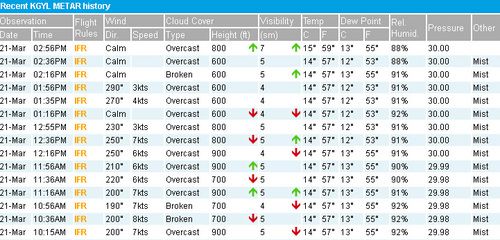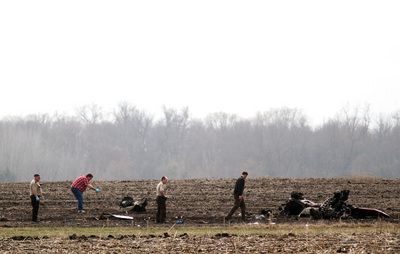As usual in the immediate aftermath of a plane crash, some of the initial facts and witness accounts don’t quite add up. That’s the case for the plane crash in Glencoe today that claimed three lives.
The accident occurred around 11 a.m.
The plane was not under air traffic control supervision, according to FAA spokeswoman Elizabeth Isham Cory.
That’s one part that doesn’t add up. Here’s why: This is the weather observation at the nearby airport at the time of the crash, according to the website, FlightAware.
The weather at the time of the crash was five miles visibility and overcast at 900 feet above the ground. In that area, the so-called Class E airspace begins at 700 feet above the ground and requires the pilot to stay 500 feet below clouds. That’s fairly impossible in this case, it would have required the pilot to fly 200 feet above the ground (and there are three towers in the vicinity that are at least 300 feet high). Just minutes before the crash, the cloud cover was reported as “broken,” indicating deteriorating weather.
That means the pilot was likely operating in instrument flight conditions, which would have required him/her to be in some sort of contact with air traffic control. If he/she wasn’t — as the FAA indicated — it means the pilot was flying by visual flight rules in conditions when VFR flight isn’t allowed.
Meanwhile, just a few dozen miles away at Flying Cloud airport, the clouds were 2,700 feet above the ground, plenty of room for legal VFR flight.
In the other direction — Marshall — the cloud ceilings quickly went from 4100 feet to 600 feet around the time of the crash.
There is, of course, no proof that the pilot wandered inadvertently into instrument conditions, however we know a couple of things: (a) the conditions were right to trap a pilot into flying into so-called IMC and (b) inadvertent flight into instrument meteorological conditions is one of the most common causes of aircraft accidents.
Here’s what it looks like when it happens:
It’s not known — yet — whether the pilot in today’s crash was instrument rated. If so, he/she would’ve contacted air traffic control. If not, it’s very easy to lose situational awareness and a sense of which way is “up,” that often leads to a stall/spin. So can efforts to stay out of such conditions.
It’s possible — since we don’t know where the plane was traveling from or to — that the plane encountered an engine malfunction, but the relatively concentrated area of the wreckage does not suggest an attempt at an emergency landing, at least judging by this photo from MPR photographer Jeffrey Thompson.
That, of course, is not to say there wasn’t an attempt at an emergency landing, but even with wet and plowed fields, the flat terrain in the area is conducive to a successful emergency landing attempt.
The Star Tribune reported a witness in the area heard “popping sounds” shortly before the crash, but such reports have been shown to be notoriously unreliable in previous crash investigations.
It’s a mystery, but not one without clues to consider.


